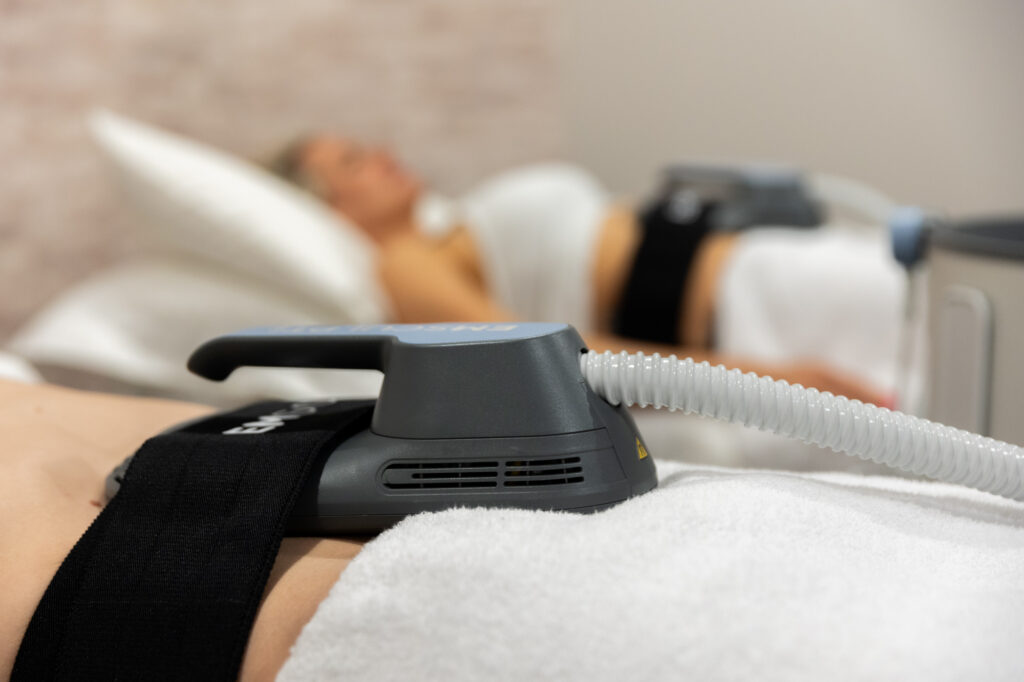News
Bridging the gap: Understanding ab separation
This blog by Essential Alchemy is authored by Audrey L Ng.
Abdominal muscle separation, medically known as diastasis recti, is a common yet often misunderstood condition affecting many individuals, particularly pregnant and postpartum women. Characterised by a gap between the rectus abdominis muscle bellies, this condition can lead to a range of physical discomforts and complications if left untreated. Understanding the causes, symptoms, and effective treatments for abdominal muscle separation is crucial for those affected.
Continue reading to find out more about diastasis recti, as we explore its risk factors, diagnosis, and various approaches to healing and prevention, providing a comprehensive guide to bridging the gap in your abdominal health.
Are you experiencing ab separation? Book a free consultation to hear about Emsculpt NEO and how it can help.
What is abdominal muscle separation (Diastasis Recti)?
Abdominal muscle separation, commonly known as diastasis recti, occurs when the rectus abdominis muscles, the “six-pack” muscles, separate along the midline of the stomach. This separation results in a bulge down the centre of the abdomen, often noticeable when straining or contracting the abdominal muscles. Diastasis recti can affect both men and women and is most commonly due to stretching of the abdominal wall during pregnancy.
Causes and risk factors of abdominal muscle separation
Abdominal muscle separation, or diastasis recti often occurs in pregnancy, primarily caused by excessive intra-abdominal pressure, rapid weight gain, and rectus abdominis contraction when the abdomen is distended. Here are the key causes and risk factors:
Causes
- Pregnancy: The growing uterus and possibly hormonal changes can contribute to the fascia and connective tissue of the abdominal muscle wall to stretch and separate. (1) (2)
- Rapid weight gain: This can cause an increase in intra-abdominal pressure resulting in a widening of the distance between the rectus abdominis muscles due to loading.
- Improper heavy lifting: Incorrect lifting techniques such as breath holding can also cause a sudden rise in intra-abdominal pressure, placing strain on the abdominal wall.
- Crunches when the abdominal wall is on stretch: during the second and third trimester of pregnancy can overload the weakened linea alba (fascia and connective tissue).
Risk factors
- Multiple pregnancies: Repeated stretching may weaken the abdominal wall over time.
- Large babies or multiple births: Increased uterine size applies places more stretch on the abdominal wall.
- Advanced maternal age: Decreased muscle elasticity and weaker connective tissue in older mothers may increase the risk.
- Genetic predisposition: collagen insufficiency in the linea alba may increase the risk of abdominal separation. (3)
- Chronic coughing or constipation: Persistent straining raising intra-abdominal pressure and load of abdominal wall.
- Previous abdominal surgery: Scarring and inadequate recovery can weaken the abdominal wall.
Understanding these causes and risk factors helps identify those at risk and implement preventive measures to reduce the likelihood of developing abdominal muscle separation.
Symptoms and diagnosis of Diastasis Recti
Common symptoms of diastasis recti include a visible bulging or hollowing through the linea alba, the connective tissue vertically separating the abdominal wall when the rectus abdominis muscles are contracted. Lower back pain related to suboptimal posture as a result of a weakened abdominal wall may also be experienced.
Interestingly, post partum abdominal separation causes greater emotional rather than physical pain. (1) .. A women’s health physiotherapist can determine whether you have an abdominal diastasis by checking and measuring the distance between the rectus abdominis muscles using calipers or Trans-abdominal Ultrasound.

Surgical and non-surgical treatment options for diastasis recti
For cases of diastasis recti, surgical options can range from a smaller hernia-type repair to a full abdominoplasty (tummy tuck) to repair the abdominal wall. Non-surgical treatments include physical therapy with a women’s health specialist, guided exercise programs, binding for compression, and the wearing of support garments.
Another innovative, non-surgical option is Emsculpt NEO, which combines high-intensity focused electromagnetic (HIFEM) technology with radiofrequency (RF) energy to strengthen and tone the abdominal muscles while reducing fat. This treatment induces powerful muscle contractions that cannot be achieved through voluntary exercise, promoting accelerated muscle growth and enhancing muscle definition.
At Essential Alchemy, we offer Emsculpt NEO as part of our medical aesthetic treatment options at our Medi spa in Perth. Emsculpt NEO provides clients with a cutting-edge solution to address diastasis recti. This treatment helps bridge the gap in abdominal muscle separation by enhancing core strength and improving overall abdominal appearance without the need for surgery.
You should always consult a healthcare provider to determine the best treatment plan based on your individual needs.
Want to know about Emsculpt NEO? Book a free consultation with one of our providers today.
Exercises and techniques for recovery of Diastasis Recti
Certain exercises can help heal diastasis recti by strengthening the core muscles without putting additional strain on the abdominal wall. These include:
- Pelvic tilts: Mobilises the lower back and begins gentle conditioning of the deep pelvic and abdominal muscles.
- Adductor Squeezes: Activation of the lower half of the anterior oblique abdominal muscle sling.
- Chest lifts and Oblique abdominal crunches: Thoracic spine mobility into flexion and rotation for activation of the upper abdominal muscle sling. (4)
- Heel Slides: Focusing on the hamstrings, deep hip flexors and stabilising layer of abdominal muscles.
Postpartum, these exercise should only be commenced after clearance at your 6-week review by your Obstetrician and if you have an abdominal separation, supervised by a Women’s Health Physiotherapist.

Lifestyle changes for managing abdominal muscle separation
In addition to exercises, lifestyle changes are essential for managing abdominal muscle separation. These include:
- Maintaining a healthy weight: Reduces unnecessary strain on the abdominal muscles.
- Optimal posture: Avoids placing additional load on the abdominal wall and connective tissues.
- Avoiding heavy lifting: Prevents further separation and injury.
- Wearing supportive garments: Maternity belts or postpartum support garments can help during the healing process. Consult a Women’s Health Physiotherapist to fit you with an appropriate binder or support garment. (5)
- Appropriately guided exercise with a Women’s Health Physiotherapist
Importance of addressing abdominal muscle separation
Ignoring abdominal muscle separation can lead to long-term issues such as chronic back pain, with the potential for pelvic floor dysfunction, and hernia. Addressing the condition is crucial for restoring core strength, improving posture, and enhancing overall well-being. Early intervention can prevent complications and promote faster recovery.
Tips for preventing abdominal muscle separation
Preventing abdominal muscle separation involves maintaining core strength and avoiding excessive strain on the abdominal muscles. Tips include:
- Gradual and safe exercise: Focus on low-impact exercises that indirectly strengthen the core in neutral spine postures, avoiding abdominal exercises such as crunches or planking.
- Proper lifting techniques: Use the legs and avoid breath holding to lift heavy objects.
- Controlled weight gain during pregnancy: As well as following guidelines to avoid excessive abdominal pressure and bearing down.
- Pregnancy-specific exercises with a Physiotherapist or trained Health Professional: Prepares the body appropriately for the demands of pregnancy while adjusting for the emotional and physiological changes.
Take proactive steps to heal abdominal separation with Essential Alchemy
By understanding abdominal muscle separation, its causes, and the best ways to address it, individuals can take proactive steps to heal and strengthen their core. Whether through targeted exercises, lifestyle adjustments, or medical interventions, overcoming diastasis recti is achievable with the right approach.
At Essential Alchemy, we offer expert guidance and personalised treatment plans to help you effectively manage and overcome abdominal muscle separation. Take the first step towards a stronger core and better health by visiting Essential Alchemy and scheduling your consultation today.
Contact Us
References:
- Keshwani N, Mathur S, McLean L. Relationship between interrectus distance and symptom severity in women with diastasis recti abdominis in the early postpartum period. Phys Ther. 2018 Mar ;98(3):182-90. doi: 10.1093/ptj/pzx117
- Chen MH, Hu CK, Chen PR, Chen YS, Sun JS, Chen MH. Dose-dependent regulation of cell proliferation and collagen degradation by estradiol on ligamentum flavum. BMC Musculoskeletal Disord. 2014 Dec; 15(1):1-0. doi: 10.1186/1471-2474-15-238
- Blotta RM, Costa SD, Trindade EN, Meurer L, Maciel-Trindade MR. Collagen I and III in women with diastasis recti. Clinics. 2018;73. 10.6061/clinics/2018/e319
- Lee D, Hodges P. Behaviour of the linea alba during a curl-up task in diastasis rectus abdominis: a new interpretation with clinical implications. Physiotherapy. 2015 May 1;101:e580-1
- Keshwani N, Mathur S, McLean L. The impact of exercise therapy and abdominal binding in the management of diastasis recti abdominis in the early post-partum period: a pilot randomised controlled trial. Physiotherapy Theory and Practice. 2019 Oct 25:1-6.
